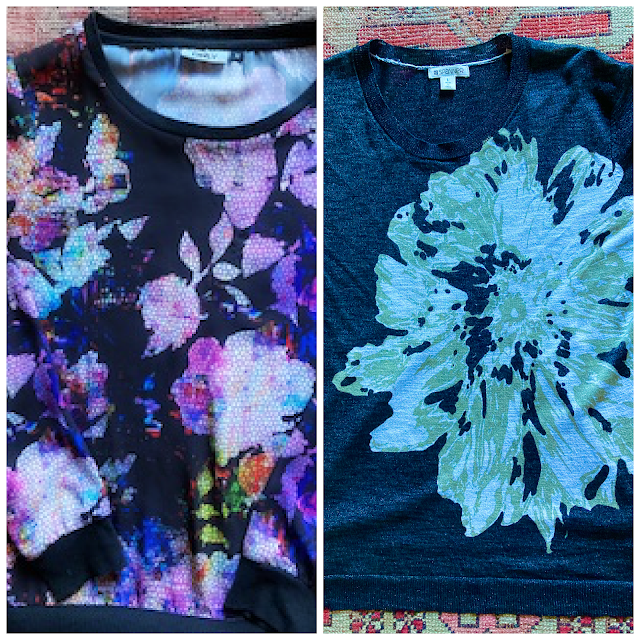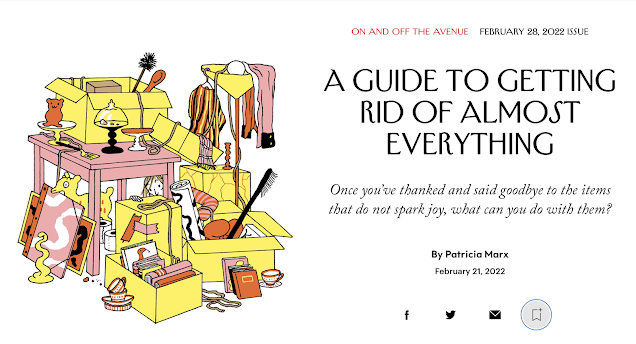Thrifting: Spring picks and politics
It's a bleak time, and I want to acknowledge the suffering and dislocation of so many as we watch the invasion of Ukraine. This post is about the "small-p" politics of consumption, which is but one element in the decision of what we value, what kind of social order we support.
There's a tempest brewing in a secondhand teapot: anti-consumption critics attack thrift shoppers, blaming them for stripping racks and raising prices at the Sally Ann. "Who is to Blame for the Increase in Thrift Store Prices" by Elise Nezir, is a capable—if haphazardly edited—summary of what's happening, and if you like to "pop some tags/at the thrift store down the road", worth your time.
Of the vitriol, Nezir says: "...instead of blaming larger systems and structures, individuals face the brunt of the backlash. While social media’s role in the evolution of thrifting is worth discussing, the real problem is that we live in a hyper-consumerist and hyper-capitalistic society. People constantly feel like they need to buy more and more."
Fast fashion exists to supply the "more and new"; now we have ultra, supercharged by instant analytics, shortened manufacturing tine, rapid fulfillment. Devil, thy name is Shein. (The model is illustrated here.)
With spring in sight, my sights are on non-dainty florals. (My floral reckoning is here.) I regularly drop by a few thrifts for books and toys for the grandbunnies, so why not look at clothes too?
After months of zero-find trips, this is what I eventually bought:
Left: From the Danish brand Only, a blurred floral in my colours, with a knit waistband and cuffs.
Right: Spanner exploded-floral lightweight viscose sweater; charcoal with a fine metallic thread for a hint of sparkle.
All set for spring, except for a pair of sneakers.
"Leave those clothes for persons on tight budgets!"
Critics charge that those who theoretically could shop elsewhere are hogging the supply, starving those who can't afford costlier clothes. The highest scorn is for those who buy in thrifts to resell at inflated prices, a practice known as "thrift gentrification".
Is this unethical? Pickers have forever scoured thrifts for desirable clothes that end up fluttering from the racks of vintage clothing boutiques. With online sites, the practice is out in the open. There's hardly a visit when I don't see something in a thrift I know someone could make money on—I've even seen my donated jacket in a hip secondhand shop's window!
I don't feel guilty for thrifting because charity shops across North America receive more donations than they can move. Mountains have built up in warehouses; textile recyclers have been hit with slowdowns in markets abroad and the cost of shipping rose during covid. (Source: "Height of fashion? Clothes mountains build up as recycling breaks down"; Reuters article.) Even in normal times, only about one-third of unsold clothing is able to be recycled.
Some of the thrift over-buyers mark up the items and list on Depop or Poshmark. Let them try; the market will decide if a used tee is worth $45 plus shipping. I'm hoping they age out of their profligacy when they graduate from parents' homes (and closets).
Walking home with that grey top and a couple of Tonka trunks, I thought, I am returning to a solid, standing home. Everyone is still here, that's what's important.
How does reduced consumption connect to geopolitics? There's more room for contribution to aid organizations; in my city, local churches are requesting donations of women's and children's clothing as well as financial aid.




Comments
When I stop there I see many people who are pushing carts laden to the top with clothing and even bedspreads, and linens of all sorts. And I can tell these are people who are not selling these items on Poshmark.
I could afford to shop at local retail stores but why should I? I think we thrifters are helping to recycle and save the environment. I always donate clothing I no longer wear back to the thrift stores and have seen items I donated on their racks. I no longer shop at consignment shops because there are better items, both in quality and price, at my thrift stores.
In those days, charity shops in upmarket areas had lots of really nice things in small sizes, presumably cast-offs from rich, thin women who had a high wardrobe turnover!
I remember, in particular, a beautifully cut pale apricot marl linen jacket and wide-leg Nicole Farhi ivory linen trousers, which I scored on one visit and which looked perfect together. I was ecstatic!
For me, the main things now are to avoid any sort of mindless buying (whether new or used), to make only considered purchases and to keep overall consumption pretty low. Basically, I suppose, to buy in the same way our mothers did...
Jane in London
Jane in London
For most people, there are good reasons to buy shoes and undergarments new...
Leslie M: There is a certain element out there who are on horses so high you can't even see them.
royleen: Thanks! I hope you are well.
Joan: I agree we do a good thing by thrifting, and at same time I should acknowledge the brunt of the criticism is aimed at thrift shoppers who overbuy. I don't support the criticism of persons who buy thrift clothes and upcycle them into transformed garments, either. Maybe I'm opposed to that critique because my daughter-in-law has made some great-looking clothes (which she wears) from the fabric she repurposes from thrifted pieces.
It sounds like you have a great thrift store where you are!
Jane in London: Like you, I thrifted when a young "career girl" (as we said then) and oh what we could find and fit into! Then, frantically busy with a business and young children, I had no time. Forty years later, I have the time and enjoy the hunt, but it's true the offerings have eroded. Your last sentence perfectly distils the philosophy of the Passage.
lagatta: Yes, the street is a good option— a good chance it is taken for wear in the community.
s. So you're in NZ! I still think of that film you took me to, was just speaking of it yesterday. (I think it's you, unless several s.s comment here.) Your son sounds dashing... an 8 yr old (already!) can dash! I bought my sons' t-shirts from Value Village from birth to when they left home, brand new cotton ones donated by fun runs, product launches etc.
I suspect these critics don't remember the Depression. I don't either but my mother, who married in its trough, would buy full circle skirts at a thrift, rip them apart, and make a child's pinafore dress or skirt for my sister or me. I hate to think where a critic would find her sewing scissors.
I like the story about the altar linens, what did you make?
Re: your response to Bunny, I suspect size availability/distribution across the population plays a significant role in what ends up being available in thrifts at any one time.
Jean Shaw: I scored a great pair of Ecco shoes in a Eugene St Vinnie’s. I was there for a family memorial and had spare time, so I like to think my mother (who adored thrifts) guided me there, a bit of whimsy as this was her favourite.
I have little to add to the interesting discussion, except to emphasize that thrift stores exist to fund their missions (food bank for mine, animal shelters etc for others). I only patronize a single thrift store, because otherwise I would find too much. I lack your powers of resistance. The Food Bank Resale often has to close donations because it is inundated.
As for resellers: thrift stores provide a low cost entrance for entrepreneurs. I remember the Salvation Army in Richmond Indiana (where I taught for a time). On "Quarter Day," a small group of women would buy every single pair of jeans to sell at a flea market. Good for them. E formerly FS
Some thrifts are "nobler" than others. Value Village (not a non-profit) has been under the gun for its practices because less than people think actually ends up with the charities who donate goods. But, some for-profit thrifts donate to charity and offer job retraining, and there's the reuse benefit to all of them.
The whiff of disapproval I sometimes encountered in my twenties and thirties when I said something I wore was secondhand has entirely vanished, it's considered cool.
This is my most recent and from that sale. I love working with vintage table linens. This was very challenging to lay out to maximum advantage.
https://lasewist.blogspot.com/2021/02/a-cobbled-white-shirt.html
I have more linens left to sew from that sale and yet am still am accumulating more as I continue to thrift. I love painting and dyeing them, such fun.
And thank you Bunny, and every one.